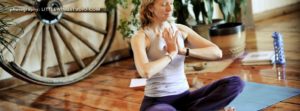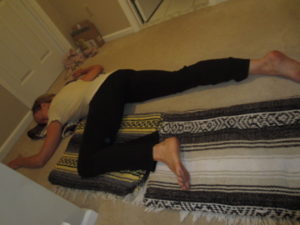Daily Sadhana for The Yoga Therapist (and anyone)
When it comes to the practice of yoga, teachers are often revered as having some kind of super-human powers. Capabilities beyond that of the average person, yogis are sometimes thought to be able to twist into incredible pretzels, chant om for hours on end, and meditate anytime of day. Yoga teachers are zen….right? They don’t doubt themselves, eat pizza, become upset, or do anything regular people do – do they? Well, of course they do!
Yogis, yoga teachers, and yoga therapists are people. There is a wide variety of shapes, sizes, religious beliefs, colors, sexual orientations, dietary regimes, and lifestyle choices. Yogis, just like everyone else, also have fears, worries, and doubts. They have that ugly self-doubt and negative self-talk wheel that pops in at the most inconvenient times too.
How does one avoid, prevent, or stop the self-doubt from continuing to creep in at the most unhelpful of times? Daily practice. In particular, a daily morning sadhana is the key to releasing tension that comes with feeding the ego.
“Sadhana is the discipline of routine spiritual practice and the routine surrendering of the ego through activities such as meditation, yoga, chanting or prayer” (Yogapedia, 2019).
Sadhana can be something as simple as a morning pranayama and mudra practice. It can also be as complex as an entire hour, or more, of pranayama, asana, meditation, and more. There are many different ways to get creative with one’s morning sadhana. Utilizing a journal, tarot cards, crystals, music, essential oils, candles, incense, mala beads, reading a special excerpt from a book, etc. There are endless ways of getting creative with one’s morning practice. The key is starting the routine, and keeping it.
“Within the practice of yoga, keeping a sadhana allows practitioners to align one’s inner self each new day” (Yogapedia, 2019).
Daily sadhana is a vital practice for any yogi, and yoga therapist. A morning ritual for oneself allows us time to remember who we are. In the rat race of life, and through the “monkey mind” madness, who are you truly at your core? What is your purpose here in this one life?
When it comes to yoga therapy, the practitioner is giving a lot of oneself to the empowering healing process of another individual. To do so, it’s important for the yoga therapist to put her own oxygen mask on first, so to speak, before assisting with the oxygen mask of another. In other words, the common phrase “you cannot pour from an empty cup” rings true.
When is the best time to start and maintain a daily sadhana? Ideally in the morning before and/or during sunrise. Early morning gives way to our natural tamasic state; a quiet time of day that is naturally suited for pratyahara, withdrawal of the senses and svādhyāya, self-study. However, if it is particularly challenging for you to start and maintain a regular sadhana in the early morning, perhaps it’s better to meet yourself where you are at – the point of least resistance. Develop a routine that works for you, at a time that works for you, and stick with it. Routine is key.
The practice of daily morning sadhana is a safeguard, protection, or a boost for the yoga therapist. Not sure where to start? Here is a suggested format that can be adjusted to meet your needs:
- Light a candle, burn incense, diffuse an essential oil such as grapefruit/lemon (uplifting and awakening) or lavender/frankincense (calming and grounding).
- Utilize a mudra that suits your intention, such as gyan mudra, which brings focus and concentration.
- Incorporate a pranayama practice such as dirga (3 part breath).
- Recite your intention/mantra/Sankalpa aloud or silently.
- Chant om aloud or silently.
- Pause for meditation.
- Move through your choice of asana.
- End in savasana and/or meditation.
- In a seated position, practice pranayama such as nadi shodhana (alternate nostril breath).
- Close by reciting your intention/mantra/Sankalpa aloud or silently.
This simple outline for a morning sadhana can be expanded upon and adjusted in many different ways. Ultimately it doesn’t matter how long your morning practice is, it matters that you do it. You will begin to notice that your body, mind, and spirit crave and long for this practice. When you go without for one day, notice where your emotions/decision-making/work productivity/state of mind is at. Alternatively, when you continue your practice, notice how greatly you benefit. Keep a journal a jot down brief notes about your experience.
Notice how this practice not only helps you personally, but also benefits your clients and students.
Sources: Yogapedia. 2019. www.yogapedia.com/definition/4994/sadhana.
Article contributed by Bryana Cook, an RYT-200, RYT-500 in training, and an 800 hour C-IAYT in training through Inner Peace Yoga Therapy. She is currently an MSW, LGSW, and LICSW in training; a practicing mental health provider in a small rural Minnesota counseling office. Bryana teaches group classes, and hosts private sessions, through her nomad business Northern Namaste Yoga and co-leads yoga retreats in beautiful places with her partners in Boreal Bliss Yoga Retreats. She lives in Longville, MN with her husband, where they do their best to live an intentional life of simplicity in nature.
http://www.innerpeaceyogatherapy.com
Reclined Twist
Legs on Chair Pose Incline Variation
|
Notice the use of stuffed animals as props
|
|
See how the props fit the body
|



Leave A Comment